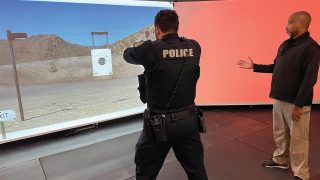
Customer service: We all complain about its downfall. We want more bang for our buck at the store. We expect questions answered and information given from a visit to the doctor, dentist and plumber. We are tired of hearing about delays because of supply chain problems or staffing shortages at department stores, grocery stores, restaurants and just about everywhere else.
Folks are saying the same about one-dimensional policing — respond and take a report. Are we universally providing crime prevention information and services? Or are we doing the minimum because of lack of staff, busy days and a lack of marketing agency services? Community engagement by the thin blue line needs to be real, without excuses.
If you scan law enforcement websites, look for crime prevention information. Is it available? Are we making an effort to have first responders or support staff/volunteers follow up with useful prevention information?
Switch places with our citizens and ask yourself if you would feel well served receiving information about policing in your city or county in general. What resources are we leaving with citizens after taking a theft, burglary or vandalism report?
Have we given up on the art of the home security survey conducted by officers or trained paraprofessionals? What is a security survey? It is an in-depth, on-site examination of a facility/residence and its surrounding property to determine its security status, define the protection needed and make recommendations to minimize criminal victimization.
Security surveys can be stimulated by local crime trends, such as a rash of burglaries. There are also watershed incidents such as active shooter events, attacks at places of worship and insurance triggers to reduce premium rates.
Where have we been?
Three programs (known as the “Big Three”) have played a key role in citizen crime prevention in the United States: crime prevention security surveys, Operation Identification and Neighborhood Watch. Security surveys have long been utilized as a tool for identifying targets that are vulnerable to crime, whether a poorly lit walkway or an unlocked window. Not surprisingly, local police are often the crime prevention experts called upon to conduct these surveys.
In the 1960s and into the 1970s, most formal crime programs constituted little more than a “public relations tactic” by police to improve their image.
The year 1971 is viewed as the birth year of crime prevention training in the U.S. It was developed at the University of Louisville, Kentucky, at the National Crime Prevention Institute (NCPI). With the help of federal funding, there was a blossoming of resources, training, staffing and state crime prevention associations.
Early security survey programming was originally funded by the Law Enforcement Assistance Administration (LEAA) dating back to the 1970s. It saw the creation of simple residential security surveys that patrol officers could conduct for citizens with basic training. Some agencies mandated such a survey when a responding officer was taking a report for residential burglaries, thefts and vandalism. This survey opportunity opened the door to discussing Operation Identification (marking valuable property with a driver’s license number) and other local crime prevention programs. It also placed something tangible in the hands of a crime victim.
Security surveys included residential and commercial walkthroughs by the police, but usually focused on homes and apartment dwellings by identifying potential targets that could be hardened (doors, windows, locks and lighting). Commercial surveys focused on employee safety and reducing robberies, burglaries and shoplifting. Some agencies would provide a security survey for financial institutions as part of a robbery prevention and response training program.
Community policing in the 1980s expanded outreach that, according to the American Crime Prevention Institute (ACPI), included efforts to address the four D’s of crime prevention: deter the criminal attack, delay the attacker, deny access to the target and detect the attack in progress. Each of the four D’s focuses on reducing opportunity.
Crime prevention training during this era was widespread, with basic and advanced crime prevention schools popping up across the country. State crime prevention associations flourished in almost every state. There was an attempt to get the word out to the masses through marketing focused on educating the public about a host of programs, from Neighborhood Watch, Operation Identification, child fingerprinting, personal safety and speakers bureaus to a host of grassroots-driven prevention programing.
By the 1990s, we saw the development of Crime Prevention Through Environmental Design (CPTED), and the application of SARA (scanning, analysis, response and assessment) as the problem-solving, crime prevention decision model that was routinely taught and encouraged for police use. Problem-oriented policing (POP) sprang up in 1999 and targeted specific crime and disorder problems. The Problem-Oriented Policing Institute became a center at Arizona State University (ASU) in 2015.
Today
While law enforcement agencies profess to embrace community policing, there is a lack of crime prevention training in many basic police academies’ curriculum. Today, only about a dozen state crime prevention associations exist in the U.S., and advanced training is limited to just a handful of sources.
Home security surveys conducted by police officers are rare today. Instead, we find agencies posting a do-it-yourself form on their website and we expect citizens to follow through. This tactic is not comprehensive; it does not involve a trained professional and it disconnects the police from community engagement. Today, even the Boy Scouts have a merit badge for crime prevention, which includes doing a security survey. Yet, most local law enforcement agencies do not engage in active security survey programs or crime prevention programming.
Examples of on-site home security services can be found at the Eugene, Oregon, Police Department (population 130,000), which has conducted home security surveys since the 1980s. Every residential property crime investigation requires patrol officers to conduct a home security survey as part of their basic investigation.
Other agencies include the New York City Police Department, which has precinct crime prevention officers providing survey services to homeowners and renters. This is not just a big-city service. Victoria, Texas, a city of 65,000; Grand Forks, North Dakota, a city of 59,000; and Franklin, Wisconsin, a city of 36,000, all provide on-site survey services. Small cities and villages dot the country with the same outreach services. All of these agencies can be used as models to build local prevention efforts.
While an on-site home survey is offered as a free service, there is a cost to the agency in the form of specialized training, staff time to conduct the survey and time involved in reaching out to the community, which equals budgeted funding.
Research confirms the effectiveness of on-site security surveys and has continued to be validated into the 2000s.
Investing in face-to-face crime prevention and security surveys is a win–win and reduces revictimization. Just like the excuses professed to be associated with supply chain delays and a lack of customer service in the private sector, the only thing anyone wants to hear is a can-do ability to deliver service.
As seen in the October 2022 issue of American Police Beat magazine.
Don’t miss out on another issue today! Click below:






